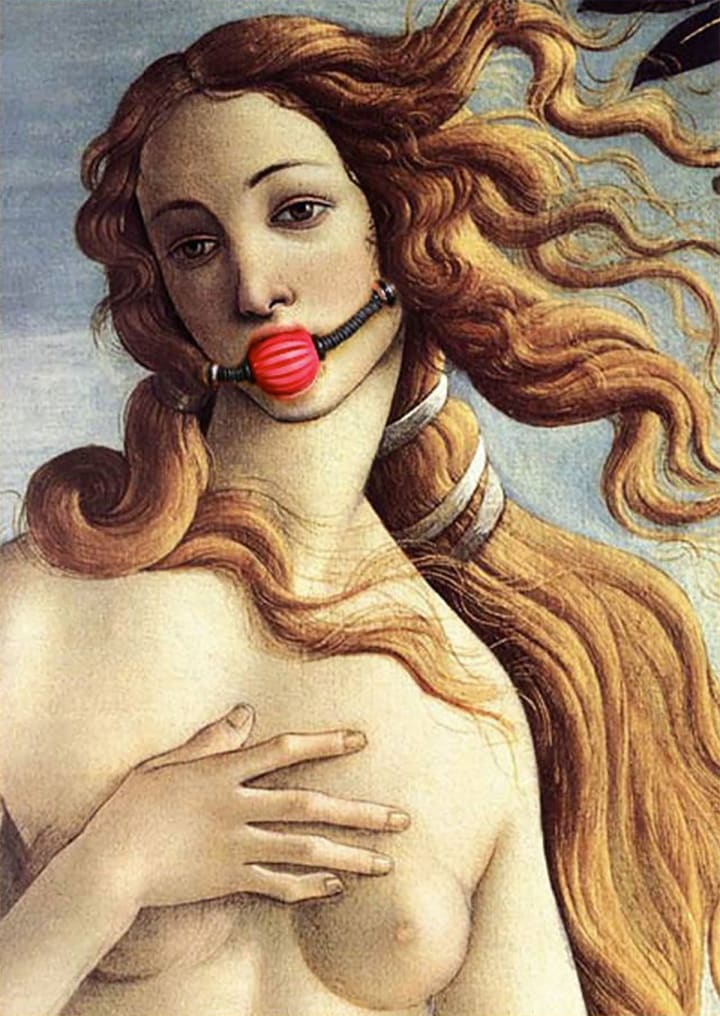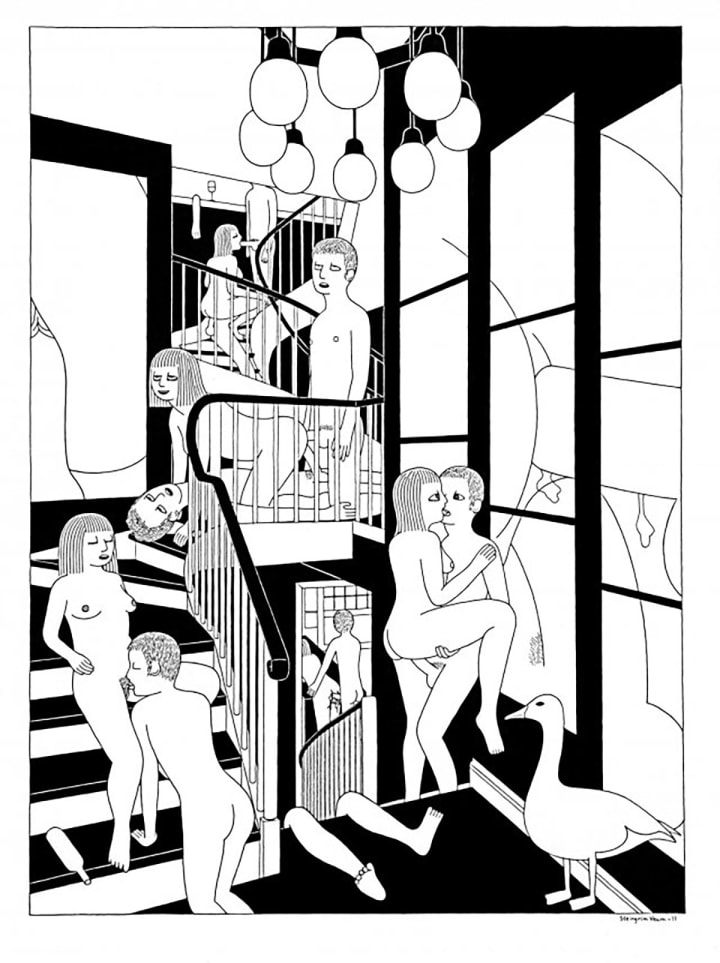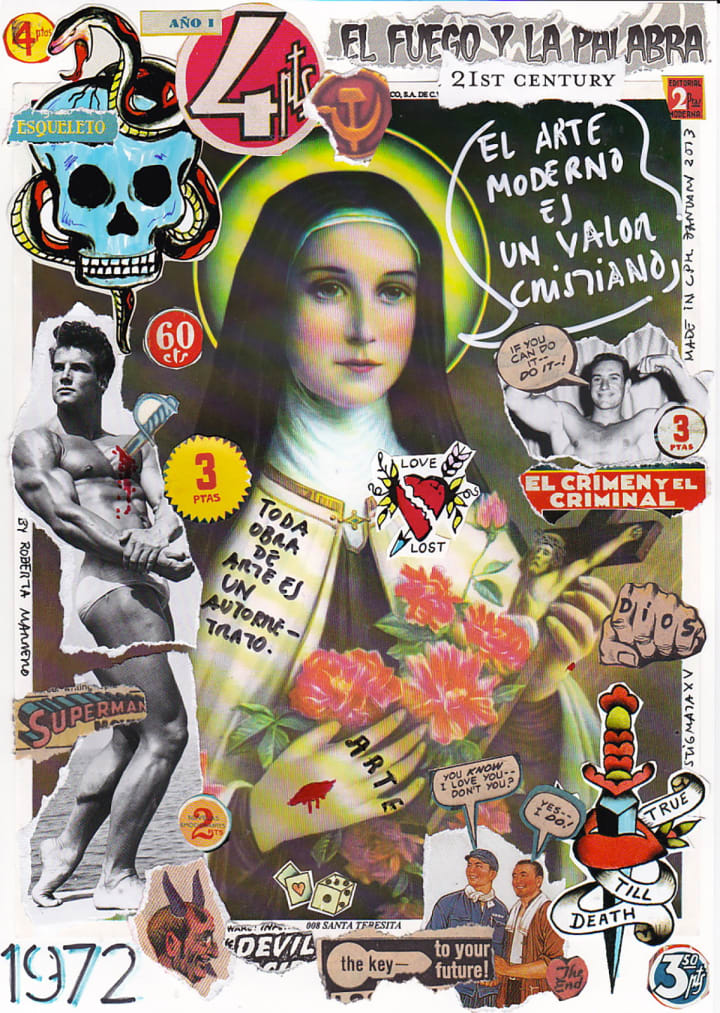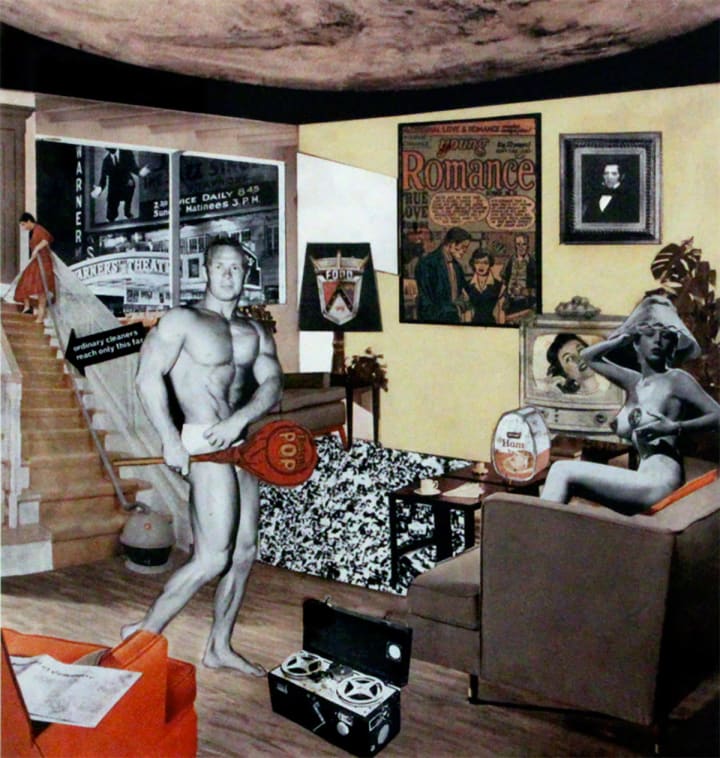History of Sex
Explore the many layers of sex and sexuality throughout history.

Sex is a part of nature. I go along with nature. -Marilyn Monroe
Humans have been doing it since the dawn of time. But just how much has the act really changed through the millennia and even throughout the past decades? Are humans doing it more? Are we doing it better? Sort of, say scientists and historians. History and science are the only ways we can determine if it has. Humans have basically been the same anatomically for about 100,000 years, so far science thinks, so it’s safe to say that if we enjoy it now, then so has everyone in past that has dipped their toe in the sea of love has too.
Those Horny, Bisexual Greeks

Image via Pintrest
When they weren’t busy having sex, the Greeks invented some pretty important stuff. From the concept of democracy to the marathon race and the actual Olympic games, we owe them a lot. However, what they may be less known for, however just as interesting, are the intriguing sexual tendencies that took place throughout ancient Grecian society. For the most part, the Greek’s strayed away from the type of incestrous relationships seen through Cersei and Jaime Lannister in HBO’s “Game of Thrones,” but they still had quite the appetite for sexual discovery.
To the Greeks, the Western world owes such inclusions in the dictionary as homosexual, lesbian, pederasty, aphrodisiac and a whole host of psychiatric derivatives. In short, if the Greeks had not shown the way, we would be without words to define about half of the activities in our bag of sex tricks.
It is a matter of conjecture, but we probably would have had just as much fun. However, it is helpful to be able to classify what we have just done. We might want to try it again. In that respect it is suitable that we begin any writing which is to be dedicated to an improved understanding and outlook on sex with a brief salute to the Grecian civilization.
The documented saga of sex goes back to an era five hundred years before the birth of Christ, and evolves during the golden age of Greece. The prime object of their physical attention was a boy, as evidenced in the word pederasty, which comes from the words paidos and erastes and refers to the love of boys.

Image via Saatchi Art
Many famous Greeks put their thoughts to writing, including Aristophanes, Socrates, Ovid, Sophocles, Zenophon. These influential writers were not reluctant to express their praise for the masculine form. Plato described a scene in his Charmides, in which a beautiful boy entered a public building followed by a host of admirers. All men turned to look upon him. There was a mighty pushing and shoving to see who would have the favor of sitting next to him. Those who received a smile or a word felt as we might if Kate Upton were to compose herself in our lap.
Fortunately, for early notations in a saga of sex, there were in fact women around in the storied days of Greece. Despite a common trend of bisexuality, Greek men actually married and somehow raised families. They had that part of it figured out. It was just that they looked for beauty and sexual dalliance in the form of the youthful male. Horace and Virgil were both considered homosexual. Alcibiades was a proud and practicing homosexual. In a later day, that noble Roman, Julius Caesar, was said to have submitted himself to the caresses of Octavius; indeed, because of a notorious love affair with the King of Bithynia Caesar was epithetized on the floor of the Roman Senate as “the Queen of Bithynia”.
Prostitution, Ain't Nothing New

Image via Pintrest
The one woman in ancient Greece who was considered provocative sex prey was the prostitute, Solon, the famous law-giver, who was said to have established brothels throughout Athens for the comfort and convenience of the citizenry. From that time probably stems the commercial house of sex. The male citizens of Athens were quite pleased with the state of affairs. They patronized the brothels to such an extent that Solon was said to have built the temple of Aphrodite Pandemos with the profits. It is rumored that Presidential candidate Donald Trump may partake in similar actions if elected in order to fund the $25 billion needed for his planned wall separating Mexico and the United States. I know the Democrats sure aren’t going to pay for it.
Today, we have the distinction between the highly paid call girl and the street hustler. In early Greece there were three separate divisions of prostitutes. The common ones were known as pornae; they lived in ordinary brothels with proper advertising identification affixed to the front door – a wooden, brightly colored phallus, if you wish to be explicit. A step up the sexual ladder were the auletrides. They were able to add to the art of sex the talents of singing and dancing. At the top of the ladder was the Hetaerae, the highly refined courtesan. Her rates ran high but it is said so did her accomplishments.
Rates for sexual dalliance ran somewhat the gamut in early Greece that they do now. The price for the common pornae was two drachmas, about two dollars. Phryne, a well known hataerae of the day, charged one hundred drachmas. Gnathaena asked one well-heeled citizen for a thousand drachmas. Lais quoted Demosthenes a fee of ten thousand drachmas. The going street rate today in Los Angeles is twenty dollars. The call girl will ask as high as five hundred dollars. It seems either that quality has deteriorated over the centuries or that modern mass production makes up the difference.
Apparently there was a better grade of prostitute in the golden age. The girl of today can enter the practice with little more to recommend her than the desire. The Greeks insisted upon proper training. There is an account of a lass named Neaera who was bought by a procuress in Corinth. She was first thoroughly trained in the courtesan's arts and then hired out. She was successful enough at the very beginning that two of her clients bought her outright for the sum of three thousand dollars. She later bought up her contract herself and went into business as a full-time hetaerae. She then had the misfortune to run into a pimp by the name of Stephanus. He took her downhill so fast she appeared to be in a permanent skid. Yet no one ever detracted from her abilities. She owed it all to the early schooling.
Rome Was Basically One Big Orgy

Image via Blogspot
In Rome during the era of Caesar we find much the same attitudes about sex as existed in the Greece of Socrates. Men like boys. Mark Antony who was immortalized for his love of Cleopatra was in reality a bisexual. He established something of a record in his early life as a favorite of assorted Roman noblemen. Of Cleopatra it is said that she was not an Egyptian, but half Greek and half Macedonian. Nor is she reported to really have been very sexy. She seems to have had two love affairs, one with Julius Caesar and one with Mark Antony. The weight of evidence is that she entered into those for reasons of ambition and not sexual lust.
Let there be no doubt that Roman women were around and about. Julia, daughter of Augustus himself, was married to Agrippa in the hopes of cooling her lusts. She continued on her abandoned way until hailed into court. Seneca recorded the information: “Augustus learned that she (Julia) had been accessible to scores of paramours, that in nocturnal revels she had roamed about the city, that the very Forum and the rostrum from which her father had proposed a law against adultery had been chosen by the daughter for her debaucheries, that she had daily resorted to the statue where the whores came to offer themselves and there sold her favors and sought the right to every indulgence with even unknown paramours.”
Julia was banished to the barren island of Pandateria. Five years later she was permitted to move to Reggio. She died there at the age of fifty-four, victim of tuberculosis. Although her behavior was representative of the times, her father never forgave her.
The final word on the Roman practice of love was probably penned by Ovid around A.D. seventeen. He wrote what is as true today as was then:
'Love's climax never should be rushed, I say, but worked up softly, lingering all the way. The parts a woman loves to have caressed, once found, caress, though modesty protest. You'll see her eyes lit up with trembling gleams, as sunlight glitters in pellucid streams: Then plaintive tones and loving murmurs rise and playful words and softly sounding sighs. But ne'er must you with fuller sail outpace your consort, nor she beat you in the race. Together reach the goal: “tis rapture's heights when man and woman in collapse unite.'
Religion vs. Sex

Image via Tumblr
With the breaking of the dawn of Christianity, sex fell upon troubled times. Rufus, a philosopher of the era, held that sexual acts outside of marriage were not to be tolerated. Apollonius of Tyna figured that even married love was wrought with impurity. One of the more beautiful women of the age was Hypatia. She managed to get through her lifetime a virgin. She once rebuked a young man who professed that he was in love with her by raising her skirt up to her waist, glancing down and saying, “That is what you are in love with, young man.”
So occupied with their chastity were the Christians that they told the story of the temptation of a monk. A beautiful young woman came to his lonely dwelling to tempt him. She laid down beside him. The monk became sorely possessed by the demon. To shock himself from his spell of madness he thrust a finger into the flame of a burning candle. The pain brought him back to his senses. Came finally the time of daylight and the monk was still pure, with ten badly burned fingers.
The Dark Ages of six hundred A.D. to eleven hundred A.D. shrouded the world. Men and women became lustier but did so under the cloak of shame spun by Christendom. There were a few prominent affairs, such as when Marozia, daughter of a high official of the papal palace, got her lover made Pope in 904. Her mother secured the office for her lover in 914. In later years, Pope John XII was tried before an ecclesiastical council on charges of incest and adultery. The unlettered people mostly kept their lusts to themselves. It was not a popular time for the exhibition of natural instincts. This is not to say that the act of sex went out of style. It was conducted indoors, out of sight. Sounds pretty similar to the affairs of today. Unfortunately, celebrity golfer Tiger Woods, infamous for various sexual affairs, was unable to understand the whole, “out of sight” concept.
It took the French to get the boat back in the right canal. The game of courtly love sprang up around the eleventh century B.C. Yet the French offered a somewhat strained version of the world’s time-honored activity. A troubadour by the name of de Pradas wrote: “He knows little or nothing of the service of women who wishes to possess his lady entirely. True love is the art of pure kissing, touching, fondling and naked contact of the lovers.” But that meant without any coital contact. Since that was the accepted standard, one does wonder where all of the court bastards came from.

Image via Pintrest
Out of the sixteenth century was born the Reformation. Luther found the sexual side of marriage a pleasant experience. He encouraged it, while strictly deposing against extra-curricular activity. A little past the midpoint of the century the Puritans set sail for America. They took with them a black plague of anti-sex and witch burning. John Calvin had earlier enunciated the code. Fornication was cause for exile, adultery deserved death. Even legitimate love was closely regulated. In 1660 in New Haven, Connecticut a young couple was summoned into court on an indictment which read: “In the presence of others these shameful people sat down together, his arm being about her, and her arm upon his shoulder or about his neck; and he kissed her and she kissed him, or they kissed one another, continuing in the posture for about half an hour.”
Charles II lit the fires in England. He supported the Duchess of Cleveland at about seventy thousand dollars a year; the Duchess of Portsmouth at about forty-five thousand dollars a year; and Nell Gwyn at around twenty thousand. The taxpayers never seemed to mind the sexual strain so much as they did the financial stress. They had an excellent example provided them, but it was paid for out of the public treasury. Times have not changed much. Remember the story about the thirteen Secret Service agents who hired prostitutes during a presidential trip to Cartagena, Columbia in 2012? It is still unclear who picked up the tab. The England of the early eighteenth century also saw a few turns in the tide of sex. The coffee houses and taverns of that day were not frequented by the ladies, but the keepers knew their business. They staffed their places with barmaids. Brown, writing in THE SPECTATOR, said: “Every Coffee House is illuminated both without and within doors; without by a fine glass lantern and within by a woman so light and splendid you may see through her without the aid of a perspective. At the bar the good man always meets a charming filly or two who invite him by their amorous glances into their smoky territories, to the loss of your sight.” The forerunner of the modern day B-girl.
Jean-Jacques Rousseau, one of the guiding lights of the French Revolution, took a beating on his posterior at the age of twelve from the sister of a pastor with whom he was boarded. The woman observed to her astonishment that Rousseau was erotically aroused by the beating. For the rest of his life Rousseau hungered for cruelty at the hands of women. Yet he devoted a portion of his writings to idealizing the pure and maternal characteristics of womankind and thus encouraged evolution of the kind of a female no one else could get along with. What Rousseau really sought was the perpetual mother. Many who followed had to pay the price. E.L. James’ 50 Shades of Grey and the hit film starring Dakota Johnson, may have been loosely based on Rousseau’s experiences with women during the eighteenth century.
The nineteenth century, under the influence of Victorian England, was a pure shambles for the sexually oriented person. A woman who had been born in the middle of the Victorian era, who had borne her husband several children, admitted to Havelock Ellis that she had never seen her husband nude. Elizabeth and Robert Browning were said to have never seen each other nude. William Hammond, a surgeon-general of the United States, wrote that nine-tenths of the time decent women felt not the slightest pleasure in intercourse. A Swiss gynecologist labeled sexual desire in young women as pathological. The result of such public expressions of sentiment was that the average husband and wife were apt to enter into coitus as a dark-and shameful thing, negotiated largely for the child producing function.
The words sadism and masochism were heard in the land. Sadism derived from the Marquis de Sade, French writer and author of LES CRIMES DE L’AMOUR. Masochism derived from Von Sacher-Masoch, author of VENUS IN FURS.
Sex Throughout the Last Century

Image Art Majeur
The Lost Generation of the Twenties kicked the sexual gong clanging down the road. The gin flask was on the hip and the era of rigid morality was given a kick in the knickers. The girl who wasn't susceptible to vigorous petting was about as welcome as Ramsay Bolton trying to apologize to the Stark’s. The girl who was ready to go all the way was having her day.
The custom of dating established itself in the thirties. Nor were couples backward about admitting the part sex played in their pairing. In a survey of a thousand couples made in the latter part of the thirties, a great majority stated that strong physical attraction was a conscious part of their magnetism for each other. Over one-third of the couples admitted to sexual intercourse. I’d like to imagine those numbers are up in the 21st century, as sex has become a vital component of any healthy relationship.
In the forties, the fear became that women were losing their sex drive, that they were bogging down in a morass of dis-satisfactions and neuroses. Dr. Marynia Farnham called them “the lost sex generation”. Men began to fasten their attentions, under the influence of Hollywood, to such appendages as legs and bosoms. Thus originated the infamous “ass or boob” debate.
The fifties found a situation in which the divorce rate was up, the suicide rate was up, the incidence of mental disorder was up, and most importantly the independence of woman was up. An added factor which may or may not explain anything was that incidence of homosexuality was up.

Image via Tumblr
Jump forward to the 21st century though, and what were once deviant sexual trends have dynamically evolved. Women are more sexually independent than ever, driven by progressive movements like Free The Nipple, started by Lina Esco.
Interestingly enough, dating in the 21st century has been largely defined by the “hook-up culture,” where millennials are choosing sex rather than dating at an astonishing rate. Overall interest in sex is up as well, as articles, books, and movies on a plethora of sexual topics have spread like wildfire across the Internet and media.
As for the future of sex, who knows where we will go from here. For now, all we can do is live by the wise words of Woody Allen that the Greek’s surely followed:
'I don’t know the question, but sex is definitely the answer.'
About the Creator
George Gott
Writer & Social Media Editor for Jerrickmedia who is an avid reader of sci-fi and a fierce defender of women, minority, and LGBTQ rights.






Comments
There are no comments for this story
Be the first to respond and start the conversation.